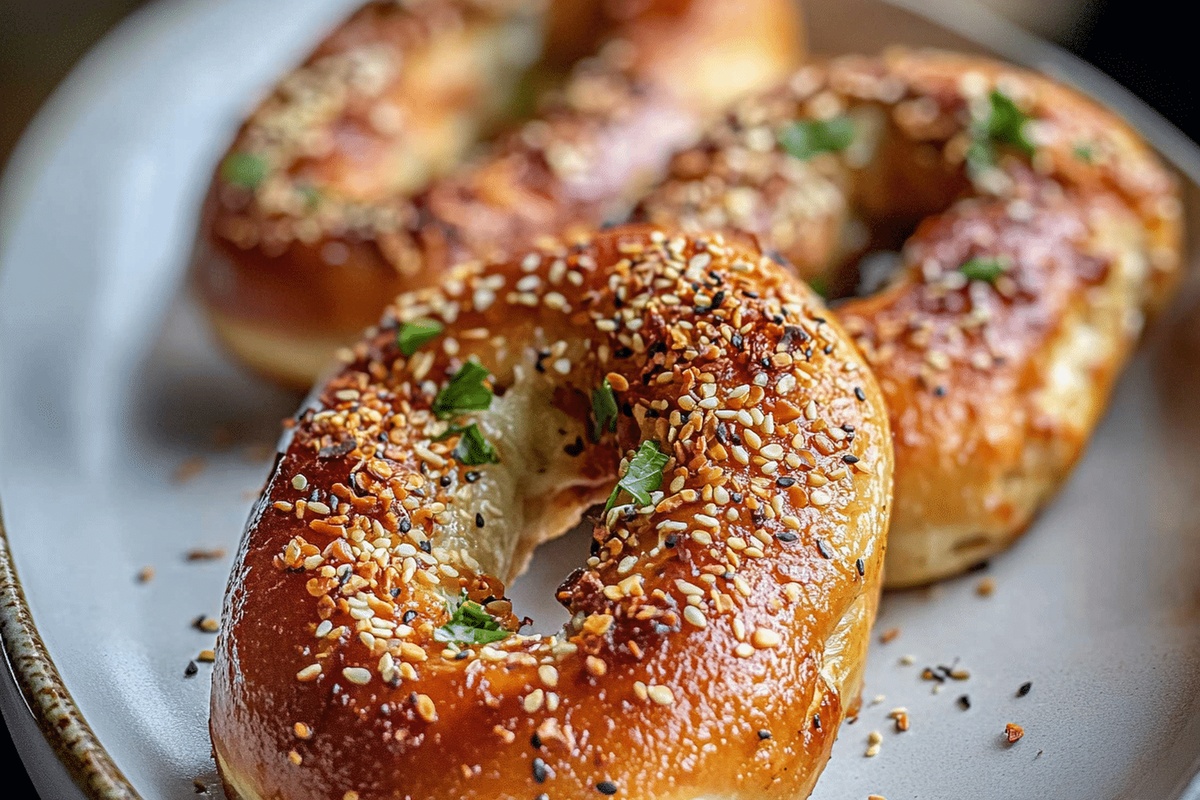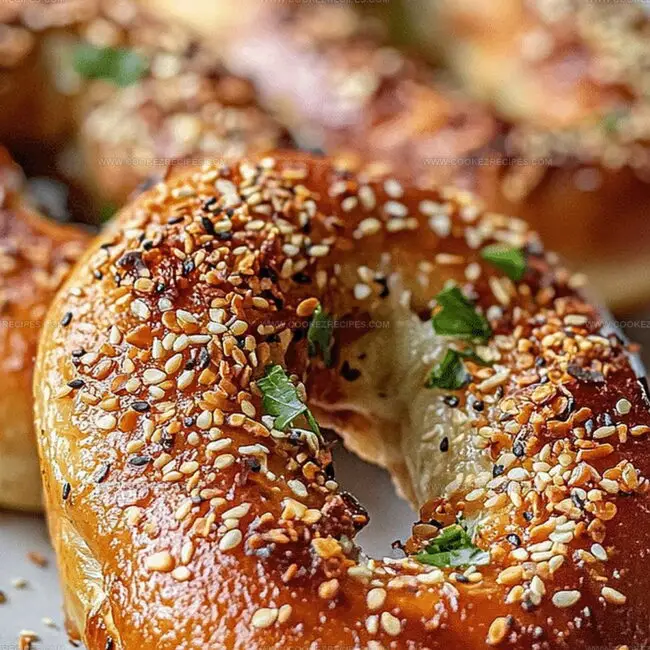Flavorful Jerusalem Bagels Recipe: A Homemade Delight
Crispy, golden jerusalem bagels have been my secret weekend breakfast obsession lately.
Neighborhood bakeries around Jerusalem inspire this delightful recipe with their traditional street-style approach.
Soft inside and wonderfully crusty outside, these oval-shaped treats capture the essence of Middle Eastern baking traditions.
My grandmother first shared her version during a memorable trip to Israel years ago.
Sesame seeds dance across the surface, adding nutty complexity and irresistible texture.
Warm kitchen aromas will draw everyone to the table, promising a delicious shared moment.
Jerusalem Bagels That Add Something Special
What Shapes Jerusalem Bagels
Flour Ingredients:Liquid and Fermentation Ingredients:Seasoning and Flavor Ingredients:Topping Ingredients:Optional Serving Accompaniments:Jerusalem Bagels Step-by-Step Directions
Step 1: Prepare Dough Base
Grab your stand mixer or large mixing bowl.
Toss in flour, sugar, salt, yeast, baking powder, and warm milk.
Blend everything together using a dough hook until you get a smooth, elastic dough ball that looks silky and stretchy.
Step 2: Let Dough Rise and Expand
Gently massage olive oil all over the dough.
Cover with a clean kitchen towel or plastic wrap.
Place in a cozy, warm spot in your kitchen and let it grow and puff up until it doubles in size.
This might take around 1 hour in warm conditions or up to 2 hours if your kitchen is cooler.
Step 3: Craft Sesame Coating
In a shallow dish, blend sesame seeds with honey and hot water.
Mix until the seeds get slightly damp and stick together without becoming a clumpy mess.
Step 4: Shape Bagel Rings
Punch down the risen dough and transfer to a floured surface.
Slice the dough into 6 equal chunks.
Roll each piece into a long 12-inch log.
Connect the ends to form circular bagel shapes.
If the dough feels tight, let it relax for a few minutes before shaping.
Step 5: Dress and Bake Bagels
Crank your oven to 425°F.
Line a baking sheet with parchment paper.
Dunk each bagel into the sesame mixture, pressing gently so seeds stick nicely.
Arrange bagels on the prepared sheet.
Bake for 15-18 minutes, rotating midway, until they turn a deep golden brown.
Step 6: Cool and Enjoy
Allow bagels to cool slightly.
Serve with za’atar, labneh, hummus, or whatever spread makes your taste buds dance.
Bagel Texture Tips From Jerusalem
Bagels From Jerusalem That Store Soft and Chewy
What Goes With Bagels At Brunch
Jerusalem Bagel Style Ideas
FAQs
Yes, Jerusalem Bagels are softer, less dense, and have an oval shape compared to traditional round, chewy New York-style bagels. They’re lighter and more elongated, typically topped with sesame seeds and have a slightly sweeter flavor profile.
Sesame seeds are a traditional Middle Eastern ingredient that adds nutty flavor, crunch, and nutritional value. The seeds are mixed with honey and water to help them stick to the bagel’s surface, creating a signature golden-brown coating when baked.
Absolutely! You can mix and knead the dough by hand. Use a large bowl and knead for about 8-10 minutes until the dough becomes smooth and elastic. The key is developing the gluten through consistent kneading.
All-purpose flour is ideal for this recipe. It provides the right protein content for a soft, tender texture. If you want a slightly chewier bagel, you can substitute up to 25% of the all-purpose flour with bread flour.
Print
Jerusalem Bagels Recipe
- Total Time: 30 minutes
- Yield: 12 1x
Description
Warm, golden Jerusalem bagels bring Middle Eastern street food magic to your kitchen. Sesame-studded and perfectly chewy, these breads offer a delightful journey through Jerusalem’s culinary traditions you can savor at home.
Ingredients
Main Ingredients:
- 4 cups (500 grams) all-purpose flour
- 1 1/2 cups (360 milliliters) milk
- 1 tablespoon instant yeast
Supplementary Ingredients:
- 2 tablespoons sugar
- 2 teaspoons kosher salt
- 1 teaspoon baking powder
- Olive oil (for brushing)
Topping Ingredients:
- 1/2 cup (75 grams) sesame seeds
- 2 tablespoons honey
- 1 tablespoon hot water
Instructions
- In a robust mixing vessel, amalgamate flour, sugar, salt, yeast, baking powder, and warm milk into a cohesive, elastic dough using a dough hook or manual kneading technique. Work the mixture for 5-6 minutes until a smooth, supple texture emerges.
- Massage olive oil across the dough’s surface, drape with a protective cloth, and allow fermentation in a cozy environment. Wait until the volume doubles – approximately 60-120 minutes depending on kitchen temperature.
- Create a sesame coating by blending sesame seeds with honey and hot water. Ensure the mixture achieves a consistent, lightly moistened consistency without excessive clumping.
- Deflate the risen dough and transfer to a lightly dusted work surface. Segment the mass into six uniform portions. Elongate each segment into 12-inch cylindrical shapes, then carefully connect ends to form circular structures. Permit brief resting if dough feels resistant.
- Heat the oven to 425°F. Prepare a parchment-lined baking sheet. Immerse each bagel into the sesame mixture, gently pressing to secure seed adherence. Arrange on prepared surface.
- Bake for 15-18 minutes, rotating midway to guarantee uniform caramelization. Seek a deep golden-brown exterior indicating perfect doneness.
- Allow brief cooling before serving. Complement with traditional Middle Eastern accompaniments like za’atar, labneh, or robust hummus for an authentic culinary experience.
Notes
- Opt for fresh active dry yeast to ensure the dough rises properly and develops a rich, airy texture.
- Use lukewarm milk (around 110°F) to activate the yeast without killing it, creating the perfect rising environment.
- Allow extra rising time in cooler kitchens, as temperature significantly impacts dough development and final texture.
- Experiment with sesame seed ratios – mix white and black seeds for a more complex, visually appealing coating.
- Knead the dough thoroughly to develop gluten, which gives Jerusalem bagels their characteristic chewy consistency.
- Keep the dough surface lightly oiled during rising to prevent drying and cracking.
- For gluten-free adaptation, substitute all-purpose flour with a blend of gluten-free flour and xanthan gum.
- Brush bagels with egg wash before adding sesame seeds for enhanced golden color and seed adherence.
- Store cooled bagels in an airtight container to maintain softness and prevent staleness.
- Toast leftover bagels briefly to restore their crisp exterior and warm, soft interior.
- Prep Time: 15 minutes
- Cook Time: 15 minutes
- Category: Breakfast, Snacks
- Method: Baking
- Cuisine: Middle Eastern
Nutrition
- Serving Size: 12
- Calories: 210
- Sugar: 4 g
- Sodium: 150 mg
- Fat: 3 g
- Saturated Fat: 0.5 g
- Unsaturated Fat: 2.5 g
- Trans Fat: 0 g
- Carbohydrates: 38 g
- Fiber: 1 g
- Protein: 6 g
- Cholesterol: 5 mg




Daniel Bruns
Founder & Culinary Innovator
Expertise
Recipe development for home cooks, Nutritional analysis and meal planning, Culinary education and food writing
Education
Auguste Escoffier School of Culinary Arts
Diploma in Culinary Arts and Operations
Focus: Classical and contemporary cooking techniques, Culinary entrepreneurship and kitchen management, Menu development and food cost analysis
Daniel’s story started with flour on his face and a pie in the oven at his grandma’s house. He later sharpened his skills at the Auguste Escoffier School of Culinary Arts.
His goal? Recipes so simple you’ll want to cook every night. When he’s not whipping up one-pan wonders, Daniel’s outside picking herbs, hosting neighborhood cook-offs, or baking chocolate cakes with his kids, messy, sweet, and unforgettable.